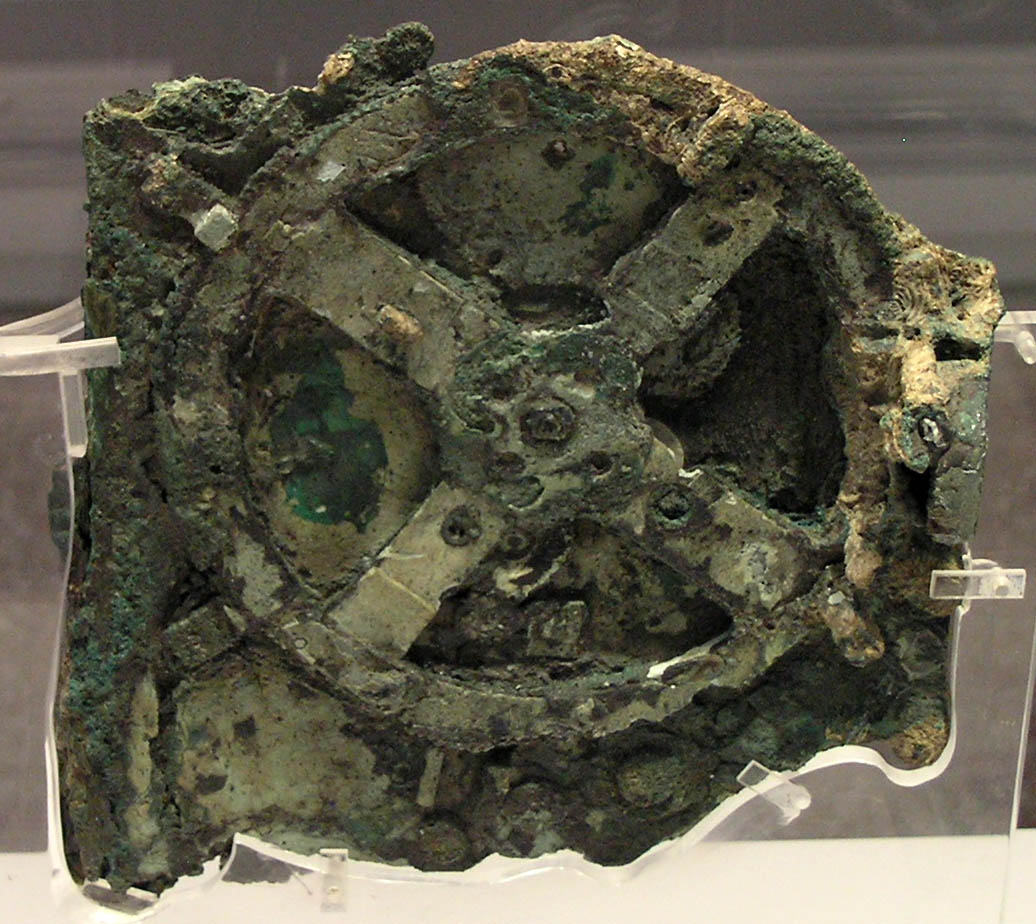BY: ROWENA MCGOWAN
What came first, the printing press or the computer? What a silly, obvious question, right? It’s clearly the computer!
Meet the Antikythera Mechanism, which could have been made as early as 220 B.C. (yes, that’s B.C.). Looks a bit steampunk, doesn’t it?
Fragment of the Antikythera Mechanism. Source.
The Antikythera Mechanism comes from a submerged Roman-era shipwreck, which was discovered by sponge divers off the coast of Antikythera, Greece (hence the name) in 1900. Excavations of the ship started later that year and continued until 1901, although it has been investigated many times since, including this year! Since the ship was a merchant vessel, it was filled with statues and other artifacts.
The Antikythera Mechanism wasn’t a particularly impressive sight when it was first found, just lumps of corroded metal. 82 fragments were recovered. They, along with the rest of the shipwreck’s objects, were sent to the National Museum of Archaeology in Athens, where they remain to this day.
Fragments of the Antikythera Mechanism on display at the National Museum of Archaeology.
Photo by Rowena McGowan.
It didn’t take researchers long to discover that the mechanism was something special. The development of techniques such as radiography and CT scans allowed the interior of the mechanism to be examined, which revealed new details about how it might have worked and inscriptions on the inside.
Calling it a ‘computer’ is actually a bit of an exaggeration and I’ll explain why I deliberately used that word in a paragraph or two. That doesn’t mean it’s not a complex and important piece of technology, however. The mechanism is more correctly referred to as an astronomical calculator. It was capable of showing lunar and solar cycles, as well as the positions of various stars and planets. We still aren’t completely sure how it worked or what the full mechanism would have looked like, although various theories have been proposed.
Reconstruction of the mechanism. Source.
The story of the Antikythera Mechanism provides an interesting lesson on spin and publicity. Some accounts of the mechanism like to dress it up as centuries before its time, an ancient marvel (hence why I initially referred to it as an ancient computer). In fact, three of the top frequently asked questions on the Antikythera Mechanism Research Project website are ‘Is it fake?’, ‘Is it evidence of time travel?’ and ‘Was it left by aliens?’ The answer to all of these questions is a resounding NO!
The Antikythera Mechanism is an extraordinary artifact and, yes, unique – but only because of its survival. Ancient Greece had a long and well-documented history of scientific, mechanical and astronomical development. The mechanism, far from being ahead of its time, fits neatly into that history. We have evidence from no less a person than Cicero that Archimedes was making astronomical machines, years before the creation of the Antikythera Mechanism. The strangest thing about the mechanism is that it managed to survive into the 21st century – it’s special because of its uniqueness now, not because of its uniqueness at the time it was made.
Which raises an interesting question about the way we perceive the ancient world. Why are we so likely to assume that people who lived in the past were primitives, incapable of the same complex reasoning and technological skill that we are today? Why is it more logical to some people that aliens came to Earth and left their technology behind, rather than that people back then were just as curious, just as clever and just as inventive as we are today?
Sources
Academic Team of the Antikythera Mechanism Research Project. (2015).The Antikythera Mechanism Research Project. Retrieved from http://www.antikythera-mechanism.gr
Edmunds, M. G. (2014). The antikythera mechanism and the mechanical universe. Contemporary Physics, 55(4), 263-285. doi:10.1080/00107514.2014.927280
Freeth, T. (2009). Decoding an Ancient Computer. Scientific American. Retrieved from http://www.cs.virginia.edu/~robins/Decoding_an_Ancient_Computer.pdf




No comments:
Post a Comment
Note: only a member of this blog may post a comment.